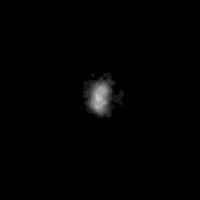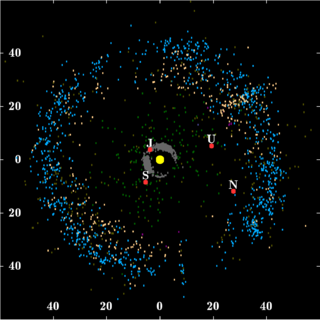
The Kuiper belt is a circumstellar disc in the outer Solar System, extending from the orbit of Neptune at 30 astronomical units (AU) to approximately 50 AU from the Sun. It is similar to the asteroid belt, but is far larger—20 times as wide and 20–200 times as massive. Like the asteroid belt, it consists mainly of small bodies or remnants from when the Solar System formed. While many asteroids are composed primarily of rock and metal, most Kuiper belt objects are composed largely of frozen volatiles, such as methane, ammonia, and water. The Kuiper belt is home to most of the objects that astronomers generally accept as dwarf planets: Orcus, Pluto, Haumea, Quaoar, and Makemake. Some of the Solar System's moons, such as Neptune's Triton and Saturn's Phoebe, may have originated in the region.
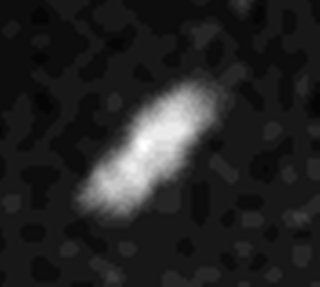
Naiad, named after the naiads of Greek legend, is the innermost satellite of Neptune and the nearest to the center of any gas giant with moons with a distance of 48,224 km from the planet's center. Its orbital period is less than a Neptunian day, resulting in tidal dissipation that will cause its orbit to decay. Eventually it will either crash into Neptune's atmosphere or break up to become a new ring.

Triton is the largest natural satellite of the planet Neptune. It is the only moon of Neptune massive enough to be rounded under its own gravity, and orbits Neptune with a retrograde orbit—an orbit in the direction opposite to its planet's rotation—the only large moon in the Solar System to do so. Because of its retrograde orbit and composition similar to Pluto, Triton is thought to have been a dwarf planet, captured from the Kuiper belt. Triton hosts a thin but well-structured atmosphere, composed primarily of nitrogen and hosting a layer of clouds.

Proteus, also known as Neptune VIII, is the second-largest Neptunian moon, and Neptune's largest inner satellite. Discovered by Voyager 2 in 1989, it is named after Proteus, the shape-changing sea god of Greek mythology. Proteus orbits Neptune in a nearly equatorial orbit at a distance of about 4.75 times the radius of Neptune's equator.

Caliban is the second-largest retrograde irregular satellite of Uranus. It was discovered on 6 September 1997 by Brett J. Gladman, Philip D. Nicholson, Joseph A. Burns, and John J. Kavelaars using the 200-inch Hale telescope together with Sycorax and given the temporary designation S/1997 U 1.
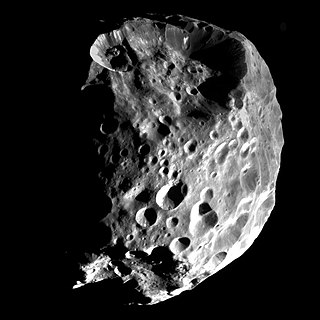
Phoebe is the most massive irregular satellite of Saturn with a mean diameter of 213 km (132 mi). It was discovered by William Henry Pickering on 18 March 1899 from photographic plates that had been taken by DeLisle Stewart starting on 16 August 1898 at the Boyden Station of the Carmen Alto Observatory near Arequipa, Peru. It was the first natural satellite to be discovered photographically.
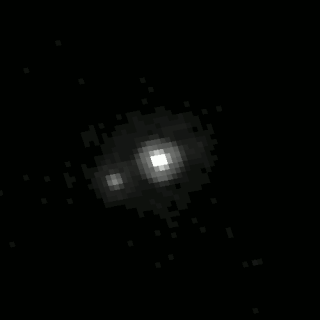
Orcus is a large trans-Neptunian object and likely dwarf planet located in the Kuiper belt, with one large moon, Vanth. It has an estimated diameter of 870 to 960 km, comparable to the Inner Solar System dwarf planet Ceres. Orcus had been accepted by many astronomers as a dwarf planet, though as of 2024 that classification remains somewhat controversial. The surface of Orcus is relatively bright with albedo reaching 23 percent, neutral in color, and rich in water ice. The ice is predominantly in crystalline form, which may be related to past cryovolcanic activity. Other compounds like methane or ammonia may also be present on its surface. Orcus was discovered by American astronomers Michael Brown, Chad Trujillo, and David Rabinowitz on 17 February 2004.

Sycorax is the largest irregular satellite of Uranus. Sycorax was discovered on 6 September 1997 by Brett J. Gladman, Philip D. Nicholson, Joseph A. Burns, and John J. Kavelaars using the 200-inch Hale telescope, together with Caliban, and given the temporary designation S/1997 U 2.
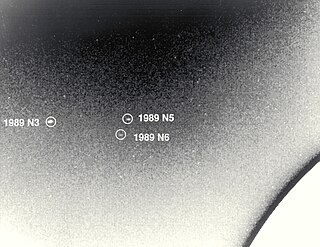
Thalassa, also known as Neptune IV, is the second-innermost satellite of Neptune. Thalassa was named after sea goddess Thalassa, a daughter of Aether and Hemera from Greek mythology. "Thalassa" is also the Greek word for "sea".
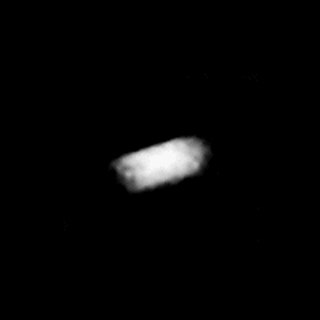
Galatea, also known as Neptune VI, is the fourth-closest inner moon of Neptune. It is named after Galatea, one of the fifty Nereids of Greek legend, with whom Cyclops Polyphemus was vainly in love.

Uranus, the seventh planet of the Solar System, has 28 confirmed moons. Most of them are named after characters that appear in, or are mentioned in, the works of William Shakespeare and Alexander Pope. Uranus's moons are divided into three groups: thirteen inner moons, five major moons, and ten irregular moons. The inner and major moons all have prograde orbits and are cumulatively classified as regular moons. In contrast, the orbits of the irregular moons are distant, highly inclined, and mostly retrograde.

The planet Neptune has 16 known moons, which are named for minor water deities and a water creature in Greek mythology. By far the largest of them is Triton, discovered by William Lassell on October 10, 1846, 17 days after the discovery of Neptune itself. Over a century passed before the discovery of the second natural satellite, Nereid, in 1949, and another 40 years passed before Proteus, Neptune's second-largest moon, was discovered in 1989.

Makemake is a dwarf planet and the second-largest of what is known as the classical population of Kuiper belt objects, with a diameter approximately that of Saturn's moon Iapetus, or 60% that of Pluto. It has one known satellite. Its extremely low average temperature, about 40 K (−230 °C), means its surface is covered with methane, ethane, and possibly nitrogen ices. Makemake shows signs of geothermal activity and thus may be capable of supporting active geology and harboring an active subsurface ocean.

38628 Huya ( hoo-YAH; provisional designation 2000 EB173) is a binary trans-Neptunian object located in the Kuiper belt, a region of icy objects orbiting beyond Neptune in the outer Solar System. Huya is classified as a plutino, a dynamical class of trans-Neptunian objects with orbits in a 3:2 orbital resonance with Neptune. It was discovered by the Quasar Equatorial Survey Team and was identified by Venezuelan astronomer Ignacio Ferrín in March 2000. It is named after Juyá, the mythological rain god of the Wayuu people native to South America.
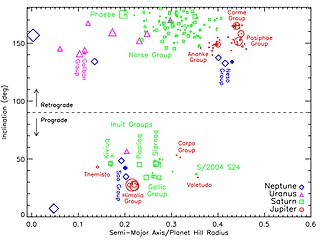
In astronomy, an irregular moon, irregular satellite, or irregular natural satellite is a natural satellite following a distant, inclined, and often highly elliptical and retrograde orbit. They have been captured by their parent planet, unlike regular satellites, which formed in orbit around them. Irregular moons have a stable orbit, unlike temporary satellites which often have similarly irregular orbits but will eventually depart. The term does not refer to shape; Triton, for example, is a round moon but is considered irregular due to its orbit and origins.
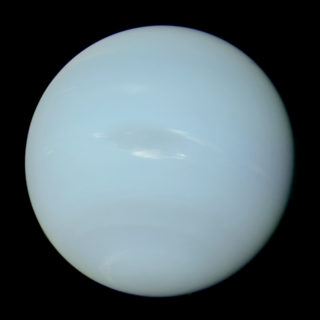
Neptune has been directly explored by one space probe, Voyager 2, in 1989. As of 2024, there are no confirmed future missions to visit the Neptunian system, although a tentative Chinese mission has been planned for launch in 2024. NASA, ESA, and independent academic groups have proposed future scientific missions to visit Neptune. Some mission plans are still active, while others have been abandoned or put on hold.

Neptune is the eighth and farthest known planet from the Sun. It is the fourth-largest planet in the Solar System by diameter, the third-most-massive planet, and the densest giant planet. It is 17 times the mass of Earth, and slightly more massive than fellow ice giant Uranus. Neptune is denser and physically smaller than Uranus because its greater mass causes more gravitational compression of its atmosphere. Being composed primarily of gases and liquids, it has no well-defined solid surface. The planet orbits the Sun once every 164.8 years at an orbital distance of 30.1 astronomical units. It is named after the Roman god of the sea and has the astronomical symbol , representing Neptune's trident.

The Nicemodel is a scenario for the dynamical evolution of the Solar System. It is named for the location of the Côte d'Azur Observatory—where it was initially developed in 2005—in Nice, France. It proposes the migration of the giant planets from an initial compact configuration into their present positions, long after the dissipation of the initial protoplanetary disk. In this way, it differs from earlier models of the Solar System's formation. This planetary migration is used in dynamical simulations of the Solar System to explain historical events including the Late Heavy Bombardment of the inner Solar System, the formation of the Oort cloud, and the existence of populations of small Solar System bodies such as the Kuiper belt, the Neptune and Jupiter trojans, and the numerous resonant trans-Neptunian objects dominated by Neptune.

Hippocamp, also designated Neptune XIV, is a small moon of Neptune discovered on 1 July 2013. It was found by astronomer Mark Showalter by analyzing archived Neptune photographs the Hubble Space Telescope captured between 2004 and 2009. The moon is so dim that it was not observed when the Voyager 2 space probe flew by Neptune and its moons in 1989. It is about 35 km (20 mi) in diameter, and orbits Neptune in about 23 hours, just under one Earth day. Due to its unusually close distance to Neptune's largest inner moon Proteus, it has been hypothesized that Hippocamp may have accreted from material ejected by an impact on Proteus several billion years ago. The moon was formerly known by its provisional designation S/2004 N 1 until February 2019, when it was formally named Hippocamp, after the mythological sea-horse symbolizing Poseidon in Greek mythology.
